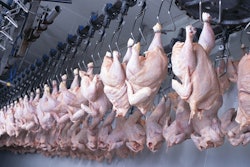
While the Italian poultry industry is hopeful of a recovery in its fortunes this year, 2022 proved to be another difficult year for the industry.
Poultry is thought to be among the sectors hardest hit by input price increases in Italy, and, while producers have been able pass costs onto consumers, data published in late October revealed that home poultry meat consumption had declined by 3.7% over the preceding 12 months.
Speaking at the Poultry Forum, held in Forlì, Italy, and organized by broiler and egg industry associations, Unaitalia and Assoavi, together with trade fair organizer Fieravicola, Antonio Forlini, President of Unaitalia, noted that the state of the industry was critical and called for greater dialogue with the country’s new government but remained hopeful of a turnaround during the year ahead.
The Italian poultry industry suffered an 80% increase in energy costs over the first eight months of 2022, while feed costs rose by 27%. It was possible to pass these increases on to consumers, although this became more difficult during the second half of the year.
The sector’s profitability, however, improved when compared to a particularly difficult 2021. The price achieved for poultry meat over the first nine months of 2022 was 18% higher than over the same period in 2021 and 22% higher than in 2019, according to data from agrifood institute ISMEA.
Forlini continued that, despite these double-digit price increases, poultry meat remains the meat of choice for Italians.
Input costs, however, were not the only reason for price increases last year; there was also reduced supply due to numerous avian influenza outbreaks in Italy. While, on the one hand, this may have helped producers to achieve higher prices, on the other, it meant that supermarkets were less inclined to offer promotions to attract consumers.

Changing consumer demands
As in other markets, there is an increasing trend toward convenience, and while whole birds may be the most economical option, it is prepared chicken meat that has proved to be most resilient at retail level.
Sales of prepared chicken are thought to have risen by approximately 20% in comparison immediately prior to the pandemic and have proved to be particularly popular with younger consumers. This popularity can be expected to continue as survey data presented at the Poultry Forum revealed that 39% of consumers intended to save money by eating more in the home and less in restaurants.

Egg production
The egg sector has been the star of animal production in Italy over recent years and, over the first nine months of 2022, sales by volume were up by 5%, while spending on eggs increased by 4.3%.
The egg market in Italy, however, is performing quite differently to that of broiler meat.
Sales fell during 2021, and in 2022 there was a strong rejection of eggs by younger consumers, with sales to this group falling by 18%. Increased spending on eggs has occurred only among those consumers aged over 55.
When taken as a whole, however, household spending on eggs in Italy is now higher than prior to the pandemic, but among the young, sales are 8-9% lower. Despite prices rising by 14%, larger and older families spent more on eggs last year than in 2021.
While expenditure on eggs may have increased, margins in the egg industry have declined, and the national layer flock contracted.
2022 was a year of two halves for the egg industry. 2021’s decline in sales continued over the first five months of 2022. However, with a return to normality post-COVID-19, and with a boom in summer tourism, demand improved during the second half, particularly from food service and for egg products. This upturn is forecast to continue into 2023.
Rising costs, weaker demand worry Italy’s poultry sector
















